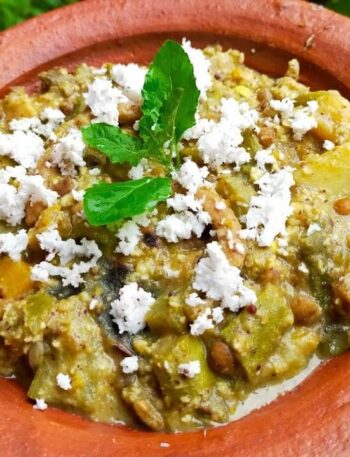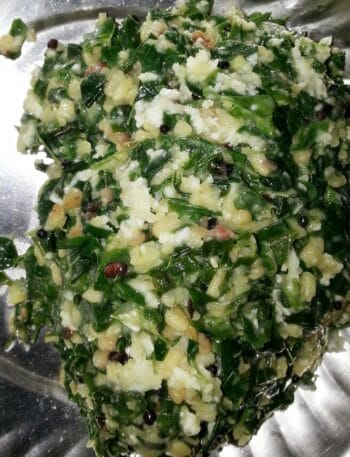(A festive variation with black chickpeas)
🛕 Origin and Cultural Significance— When Food Meets Faith! 🛕
It’s Ashtami morning. The air smells of incense, the temple bell rings softly, and in the kitchen, a pot of Chana Ghanta (ଚଣା ଘଣ୍ଟ) simmers with devotion. Chana Ghanta is one such offering made without onion and garlic, prepared with love, seasonal vegetables, and black chickpeas—a flavourful dish infused with tradition and spiritual warmth.
This isn’t just any dish—it’s a form of prayer.
If you’ve grown up in Odisha or have been part of a traditional Durga Puja celebration, chances are you’ve seen a big bowl of this vibrant dish sitting among the offerings.
What makes it so special?
Well, the word “Ghanta” in Odia refers to anything that is mixed up—hence the name. The dish is traditionally prepared with tomatoes, no onions and garlic, emphasising coconut, cumin, chillies, and ginger for flavour.
The term “Chana Ghanta” combines “Chana” (blackgram/chickpeas) and “Ghanta” (a mixed curry). It was traditionally prepared in the Jagannath Temple in Puri, as part of the grand Mahaprasad, which is offered to Lord Jagannath. The dish is a perfect fit for Satvik bhojan, followed in both temple kitchens and during holy observances like Navratri and Shraddha.
🌺 A Dish Steeped in Tradition & Community Bonding—
Festive Favourite: Chana ghanta is lovingly prepared during Durga Puja, Navratri, and Dusshera in Odisha. It is offered to Goddess Durga, especially on Asthami and Navami, representing strength and balance.
Shraddha Rituals: In ancestral offerings(Śrāddha), Chana ghanta is considered a sacred dish. Its satvik nature and nutrient-rich ingredients make it a soul-satisfying offering to the departed and a symbolic gesture of continuity and remembrance.
Everyday Heritage: Beyond temple and rituals, Chana ghanta is a household comfort food, often made with seasonal vegetables like raw banana, pumpkin, and potatoes. It’s a dish that binds generations around the kitchen and dining table.
🍽️ How to Make Chana Ghanta at Home—
Equipment Needed:
✔️ Pressure cooker – For cooking Kala Chana.
✔️Kadhai or deep pan – for making the curry/ghanta
✔️Knife and cutting board – For chopping vegetables
✔️Spatula or Karchi – For stirring
🛒 Ingredients:
🥦 Main Vegetables:
🟡 Kala Chana (Black Chickpeas) – ¾ cup black chickpeas (chana), soaked overnight, boiled
🥔 Potato – 1 medium peeled and diced
🎃 Pumpkin (Boitalu/Kakharu) – 1 cup (cubed)
🍌 Raw banana – 1 peelsed and diced raw banana
🥔 Yam (Suran) – ½ cup diced (optional)
🍆 Brinjal (Baigana) – 1 small cubed
🍠 Arbi (Saru) – ½ cup (optional)
🥒Ridge gourd or Bottle gourd – ½ cup cubed
Other Ingredients:
🥥 Grated Coconut – ¼ cup (fresh or frozen)
🌿 Ginger – 1 tsp (grated or crushed)
🌶️ Green Chillies – 1–2 (slit)
✨ Turmeric Powder – ½ tsp
🌶️ Red Chilli Powder – ½ tsp
🧂 Roasted Cumin-Chilli Powder – 1 tsp
🧂 Salt – as per taste
🧈 Ghee – 1 tbsp
Tempering (Tadka):
🌱 Cumin Seeds – ½ tsp
🌶️ Dry Red Chillies – 1–2
🍃 Bay Leaf – 1 (optional)
⚪ Hing (Asafoetida) – a pinch
🥄 Step-by-Step Cooking Instructions—
Pressure Cook the Chana:
Soak black chickpeas overnight. Pressure cook with a pinch of salt and turmeric for 3–4 whistles or until soft.
2. Prepare the Vegetables:
Chop the raw banana, pumpkin, and potato into even cubes.
3. Temper the Spices:
Heat mustard oil or ghee in a kadai. Add cumin seeds, bay leaves, and dry red chillies. Let them splutter.
4. Sauté the Veggies:
Add the vegetables and sauté for 5–7 minutes until they begin to soften. Add turmeric and salt. Mix well.
5. Combine with Cooked Chana:
Add the cooked chana to the kadai. Mix all the ingredients thoroughly. Adjust water to your desired consistency.
6. Simmer:
Cover the lid and let it cook in a low flame for 10–15 minutes, allowing the flavours to blend.
7. Final Touch:
Swirl in a touch of ghee on top.
🍽️ Best Ways to Enjoy Chana Ghanta—
🌾 Traditional Pairings:
Chana ghanta is a dry, wholesome dish, so it beautifully pairs with
✔️ Steamed Rice (Arua Chaula – bhata) ✨– The classic Odia pairing. Soft rice balances the hearty chickpeas and vegetable mix.
✔️ Pakhala Bhata – Fermented rice water dish enjoyed with Chana ghanta in the summer months.
✔️Kanika Khichdi or Habisa Dalma – 🥘 On Ashtami or during vrat (fast), it’s paired with ghee khichdi for a satvik platter.
✔️Roti or Poori – 🥟 Though less common, many enjoy Chana ghanta with freshly made roti or soft pooris during festive occasions.
🍹Beverage Pairings:
✔️ 🍋💧 Lemon-ginger Water – A warm glass of lemon-ginger water after the meal helps in digestion.
✔️ 🧉 Bela Pana – A cooling Odia fruit drink that goes well if served during summer puja feasts.
✔️🍵 Light Spiced Chai (Post-meal) – A soothing end to a festive or winter meal.
🍬 Sweets that pair well:
✔️ 🍥 Chhena Poda – Odisha’s beloved baked dessert made from caramelised cottage cheese. Slightly smoky, lightly sweet, soft within – a perfect flavour contrast.
✔️ 🍯 Khaja or Gaja – Crunchy sugar-dipped delights that are often part of festive bhog platters.
✔️Kheeri (Odia Rice Pudding) – Light and comforting; often made during Ashtami and Navami pujas.
✔️ Mitha Dali Payasa – A moong dal-based sweet dish traditionally served in Odia satvik meals.
🧊Storage & Leftover Tips—
Don’t worry if you have made a little extra — Chana Ghanta tastes better the next day as the spices deepen and settle in. Here’s how to store and enjoy it again without compromising on flavour or texture.
🧯 Cooling & Storage
Refrigeration:
- Cool the dish completely before transferring it into an airtight container.
- It stays fresh in the fridge for up to 3 days.
Freezing: (if needed)
You can freeze Chana ghanta for up to 2-3 weeks, though the texture of vegetables like brinjal or pumpkin may soften further on reheating.
🔄 Reheating Tips
Stovetop Method (Recommended):
- Reheat in a pan with a splash of water or ghee to stop it from drying out or sticking. Stir gently to keep the vegetable texture intact.
🌀 Microwave:
- Reheat on medium power for 1–2 minutes. Stir halfway and sprinkle a few drops of water before heating to retain moisture.
🌿 Health Benefits of Chana Ghanta—
Rich in Plant-Based Protein
The star ingredient—Kala Chana (black chickpeas)—is an excellent source of protein, making it a great choice for vegetarians. It helps in:
- Building and repairing tissues
- Keeping you fuller for longer
- Supporting muscle health and metabolism
Loaded with Seasonal Vegetables
From pumpkin and banana to ridge gourd and yam, the variety of vegetables in Chana Ghanta brings:
- Dietary fibre – Supports digestion and gut health
- Vitamins & minerals – Including iron, potassium, and vitamin C
- Low glycemic index – Supports stable blood sugar levels.
Satvik and Gut-Friendly
Made without onion or garlic, Chana Ghanta is:
- Easy on the stomach
- Ideal during religious fasts or detox periods
- Light yet nourishing, making it suitable for all ages
Heart-Healthy Fats
The use of ghee and coconut adds good fats that help:
- Improve cholesterol balance
- Vitamins A, D, E & K, known as fat-soluble vitamins, are absorbed.
- Promote satiety and flavour without deep frying
Spice Benefits
The simple spice blend used—turmeric, roasted cumin, and dry chilli—offers:
- Anti-inflammatory properties
- Improved digestion
- It works as an immunity booster, especially in monsoon and early winter months
Perfect for Balanced Eating
Chana Ghanta offers a complete meal profile:
- Protein from chana
- Carbs from root veggies
- Fibre & antioxidants from leafy and fleshy vegetables
- Satvik preparation makes it suitable for yogic or ayurvedic diets
💛 A Dish That Embodies Odisha’s Culinary Soul—
Chana Ghanta is more than just a festive favourite—it’s a reflection of Odisha’s deeply rooted culinary philosophy: simple, seasonal, spiritual, and sustainable.
In a land where flavour meets faith, this dish embodies how food can unite communities, traditions, and generations. Cooked without onion or garlic, using local vegetables and kala chana, it represents the quiet genius of the Odisha kitchen, showcasing everyday ingredients with minimal spice and maximum soul.
From the village kitchens of coastal Odisha to the bhog thalis of Durga Puja pandals, Chana Ghanta represents:
- ✨ Balance – A wholesome mix of protein, veggies, and natural fats
- 🌱 Sustainability – Made from seasonal, locally sourced ingredients
- 🙏 Spirituality – Offered as bhog with love and devotion
- 👵 Legacy – Passed down from mothers and grandmothers as part of festive rituals
It’s the kind of dish that brings back the scent of incense, the clinking of brass pots, and the warmth of shared meals on banana leaves.
Truly, Chana Ghanta isn’t just eaten—it’s experienced.





